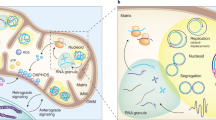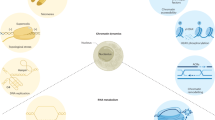Abstract
Mitochondrial genomes are unusual in that they have very low mutation rates in coding sequences when compared with animals, yeast, and bacteria. It has been proposed that the mitochondrial (mt) DNA damage is preferentially repaired by homologous recombination (HR). In this short review, we summarize and discuss the well-established and recently identified pathways that help in maintaining the integrity of plant mitochondrial genomes.

Similar content being viewed by others
References
Alexeyev M, Shokolenko I, Wilson G, et al. 2013 The maintenance of mitochondrial DNA integrity – critical analysis and update. Cold Spring Harb. Perspect. Biol. 5 a012641
Allaman I, Bélanger M and Magistretti PJ 2015 Methylglyoxal, the dark side of glycolysis. Front. Neurosci. 9 23
Ayabe H, Toyoda A, Iwamoto A, et al. 2023 Mitochondrial gene defects in Arabidopsis can broadly affect mitochondrial gene expression through copy number. Plant Physiol. 191 2256–2275
Chegão A, Guarda M, Alexandre BM, et al. 2022 Glycation modulates glutamatergic signaling and exacerbates Parkinson’s disease-like phenotypes. npj Parkinsons Dis. 8 51
Chevigny N, Schatz-Daas D, Lotfi F, et al. 2020 DNA repair and the stability of the plant mitochondrial genome. Int. J. Mol. Sci. 21 328
Cho Y, Mower JP, Qiu Y-L, et al. 2004 Mitochondrial substitution rates are extraordinarily elevated and variable in a genus of flowering plants. Proc. Natl. Acad. Sci. USA 101 17741–17746
Christensen AC 2017 Mitochondrial DNA repair and genome evolution. Annu. Plant Rev. 50 11–31
Draper CK and Hays JB 2000 Replication of chloroplast, mithochondrial and nuclear DNA during growth of unirradiated and UVB-irradiated Arabidopsis leaves. Plant J. 23 255–265
Druzhyna NM, Wilson GL and LeDoux SP 2008 Mitochondrial DNA repair in aging and disease. Mech. Ageing Dev. 129 383–390
Fournet M, Bonté F and Desmoulière A 2018 Glycation damage: A possible hub for major pathophysiological disorders and aging. Aging Dis. 9 880–900
Foyer CH and Noctor G 2003 Redox sensing and signalling associated with reactive oxygen in chloroplasts, peroxisomes and mitochondria. Physiol. Plant 119 355–364
Ghosh A, Kushwaha HR, Hasan MR, et al. 2016 Presence of unique glyoxalase III proteins in plants indicates the existence of shorter route for methylglyoxal detoxification. Sci. Rep. 6 18358
Groth P, Orta ML, Elvers I, et al. 2012 Homologous recombination repairs secondary replication induced DNA double-strand breaks after ionizing radiation. Nucleic Acids Res 40 6585–6594
Gualberto JM and Newton KJ 2017 Plant mitochondrial genomes: Dynamics and mechanisms of mutation. Annu. Rev. Plant Biol. 68 225–252
Gutman BL and Niyogi KK 2009 Evidence for base excision repair of oxidative DNA damage in chloroplasts of Arabidopsis thaliana. J. Biol. Chem. 284 17006–17012
Janků M, Luhová L and Petřivalský M 2019 On the origin and fate of reactive oxygen species in plant cell compartments. Antioxidants 8 105
Kleine T, Lockhart P and Batschauer A 2003 An Arabidopsis protein closely related to Synechocystis cryptochrome is targeted to organelles. Plant J. 35 93–103
Kohl S and Bock R 2009 Transposition of a bacterial insertion sequence in chloroplasts. Plant J. 58 423–436
Majeran W, Friso G, Asakura Y, et al. 2012 Nucleoid-enriched proteomes in developing plastids and chloroplasts from maize leaves: a new conceptual framework for nucleoid functions. Plant Physiol. 158 156–189
Malerba M and Cerana R 2021 Possible role of peroxynitrite in the responses induced by fusicoccin in plant cultured cells. Plants 10 182
Melvin P, Bankapalli K, D’Silva P, et al. 2017 Methylglyoxal detoxification by a DJ-1 family protein provides dual abiotic and biotic stress tolerance in transgenic plants. Plant Mol. Biol. 94 381–397
Nagy GN, Leveles I and Vértessy BG 2014 Preventive DNA repair by sanitizing the cellular (deoxy)nucleoside triphosphate pool. FEBS J. 281 4207–4223
Nair A, Harshith CY, Narjala A, et al. 2023 Begomoviral βC1 orchestrates organellar genomic instability to augment viral infection. Plant J. 114 934–950
Nakabeppu Y 2014 Cellular levels of 8-oxoguanine in either DNA or the nucleotide pool play pivotal roles in carcinogenesis and survival of cancer cells. Int. J. Mol. Sci. 15 12543–12557
Nakazono M and Hirai A 1993 Identification of the entire set of transferred chloroplast DNA sequences in the mitochondrial genome of rice. Mol. Gen. Genet. 236 341–346
Pang Q, Hays JB, Rajagopal I and Schaefer TS 1993 Selection of Arabidopsis cDNAs that partially correct phenotypes of Escherichia coli DNA-damage-sensitive mutants and analysis of two plant cDNAs that appear to express UV-specific dark repair activities. Plant Mol. Biol. 22 411–426
Prasad M, Kataria P, Ningaraju S, et al. 2022 Double DJ-1 domain containing Arabidopsis DJ-1D is a robust macromolecule deglycase. New Phytol. 236 1061–1074
Preuten T, Cincu E, Fuchs J, et al. 2010 Fewer genes than organelles: extremely low and variable gene copy numbers in mitochondria of somatic plant cells. Plant J. 64 948–959
Puchta H 2004 The repair of double-strand breaks in plants: mechanisms and consequences for genome evolution. J. Exp. Bot. 56 1–14
Rabbani N and Thornalley PJ 2008 Dicarbonyls linked to damage in the powerhouse: glycation of mitochondrial proteins and oxidative stress. Biochem. Soc. Trans. 36 1045–1050
Rabbani N, Xue M and Thornalley PJ 2021 Dicarbonyl stress, protein glycation and the unfolded protein response. Glycoconj. J. 38 331–340
Richarme G, Liu C, Mihoub M, et al. 2017 Guanine glycation repair by DJ-1/Park7 and its bacterial homologs. Science 357 208–211
Roldán-Arjona T, Ariza RR and Córdoba-Cañero D 2019 DNA base excision repair in plants: An unfolding story with familiar and novel characters. Front. Plant Sci. 10 1055
Rowan BA, Oldenburg DJ and Bendich AJ 2010 RecA maintains the integrity of chloroplast DNA molecules in Arabidopsis. J. Exp. Bot. 61 2575–2588
Sage JM and Knight KL 2013 Human Rad51 promotes mitochondrial DNA synthesis under conditions of increased replication stress. Mitochondrion 13 350–356
Sato N, Terasawa K, Miyajima K, et al. 2003 Organization, developmental dynamics, and evolution of plastid nucleoids. Int. Rev. Cytol. 232 217–262
Serrano I, Audran C and Rivas S 2016 Chloroplasts at work during plant innate immunity. J. Exp. Bot. 67 3845–3854
Shedge V, Arrieta-Montiel M, Christensen AC, et al. 2007 Plant mitochondrial recombination surveillance requires unusual RecA and MutS homologs. Plant Cell 19 1251–1264
Shokolenko I, Venediktova N, Bochkareva A, et al. 2009 Oxidative stress induces degradation of mitochondrial DNA. Nucleic Acids Res. 37 2539–2548
Sunderland PA, West CE, Waterworth WM, et al. 2006 An evolutionarily conserved translation initiation mechanism regulates nuclear or mitochondrial targeting of DNA ligase 1 in Arabidopsis thaliana. Plant J. 47 356–367
Takahashi S, Teranishi M, Izumi M, et al. 2014 Transport of rice cyclobutane pyrimidine dimer photolyase into mitochondria relies on a targeting sequence located in its C-terminal internal region. Plant J. 79 951–963
Tian X, Zheng J, Hu S, et al. 2006 The rice mitochondrial genomes and their variations. Plant Physiol. 140 401–410
Wolfe KH, Li WH and Sharp PM 1987 Rates of nucleotide substitution vary greatly among plant mitochondrial, chloroplast, and nuclear DNAs. Proc. Natl. Acad. Sci. USA 84 9054–9058
Xu Y-Z, Arrieta-Montiel MP, Virdi KS, et al. 2011 MutS HOMOLOG1 is a nucleoid protein that alters mitochondrial and plastid properties and plant response to high light. Plant Cell 23 3428–3441
Yakes FM and Van Houten B 1997 Mitochondrial DNA damage is more extensive and persists longer than nuclear DNA damage in human cells following oxidative stress. Proc. Natl. Acad. Sci. USA 94 514–519
Zandi P and Schnug E 2022 Reactive oxygen species, antioxidant responses and implications from a microbial modulation perspective. Biology 11 155
Acknowledgements
The authors thank Steffi Raju for comments. This study was supported by NCBS-TIFR core funds and Department of Atomic Energy, Government of India, under Project Identification No. RTI 4006 (1303/3/2019/R&D-II/DAE/4749 dated 16.7.2020).
Author information
Authors and Affiliations
Corresponding author
Ethics declarations
Conflict of interest
The authors declare that they have no known competing financial interests or personal relationships that could have appeared to influence the work reported in this paper.
Additional information
Corresponding editor: Agepati S Raghavendra
This article is part of the Topical Collection: Plant Mitochondria: Properties and Interactions with Other Organelles.
Rights and permissions
About this article
Cite this article
Nair, A., Shivaprasad, P.V. Novel regulators of mitochondrial genome integrity. J Biosci 48, 39 (2023). https://doi.org/10.1007/s12038-023-00364-0
Received:
Accepted:
Published:
DOI: https://doi.org/10.1007/s12038-023-00364-0




